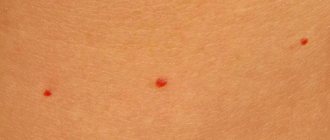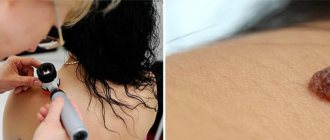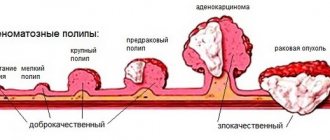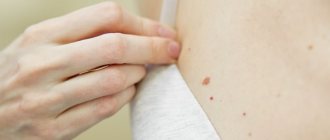Causes of red moles on the body
By its nature, a red mole is a cluster of vessels and capillaries, which normally perform the function of oxygen and nutritional supply to the epidermal structures. With the development of any internal pathological process or under the influence of exogenous factors, small vessels can connect, forming a kind of bundle, which in medicine is often called an angioma.
When asked by a patient regarding small red moles, “What is this?”, the specialist will most often answer – angioma. Typically, these pigmented formations are formed during the period of active growth of the body, that is, in early childhood, which is associated with a serious transformation of the human vascular system at this age.
A distinctive feature of red pigmented nevi is the loss of color intensity of the formation when pressing on it, which is associated with a vascular reaction. In addition, red moles normally do not hurt or itch, and do not change their shape and size over time.
The following etiotropic factors may be the causes of angiomas in adult patients:
- Excessive sun exposure (excessive ultraviolet radiation);
- Hormonal imbalance (puberty, pregnancy, menopause, etc.);
- Pathologies of the gastrointestinal tract, especially the pancreas;
- Injuries and mechanical damage to the epidermal integument;
- Diseases of the cardiovascular system;
- Violation of the formation or destruction of pigmented cells.
Today, doctors do not give a clear answer regarding the causes of red moles on the body, however, the factors listed above can become a provoking condition for their appearance.
What warts can lead to cancer? Let's discuss it with a dermatologist
Not long ago we wrote a detailed article about the types of warts and methods of treating them, you can read this link. In today’s article, we will look at the myths about warts and ask dermatovenerologist Oleg Vladimirovich Demchenko from the Moscow MC “Health” about which of them can still lead to cancer.
— Oleg Vladimirovich, is it true that warts are a precancer?
No, this is not true, and such a question has never faced doctors. Such information is distributed on the Internet without going into detail, often in order to sell a person some kind of miraculous ointment. In fact, we know that warts, or papillomas, are caused by different strains of human papillomaviruses - some of them have a high oncogenic risk, others have almost zero.
— That is, if a person has HPV, then he is at risk?
More than half of the world's population is infected with HPV. Some people live their whole lives without even noticing it, because the immune system suppresses the virus. But if immunity decreases, a person develops those same notorious warts in different parts of the body. If you have them, it makes sense to consult a doctor and get tested for HPV strains. There are a number of the most dangerous strains - 16, 18, 30, 31, 33, 39, 40, 42, 43, 52, 55, 57-59, 61, 62 and 67-70. They have an extremely high oncogenic risk. For example, 90% of malignant tumors of the oropharynx, cervix and anal canal are caused by strains 16 and 18.
— Does it happen that the strain is low-oncogenic, but a tumor has formed that is malignant?
This happens, but very rarely. In any case, a wart is a reason to make an appointment with a doctor and get checked.
— Are there
any types of warts that still indicate oncology?
Even if indirectly. Yes, these are papillomas in the nasopharynx, mammary glands, genitals and anal canal. You can’t delay with such warts. It is necessary to undergo an examination as soon as possible, eliminate the risk of malignancy and remove the resulting papillomas.
— Maybe it’s easier to buy
some ointment and cure it at home?
This is the first time I’ve heard that ointments reduce the risk of cancer. But medicine knows about the development of chemically induced tumors as a result of the use of all kinds of dubious sprays, ointments and creams. It's not worth the risk.
- They say warts can go away on their own...
This actually happens if an HPV outbreak was simply triggered by a decrease in a person’s immunity. Warts on the hands and feet sometimes disappear as a result of improved immunity and hygiene. This happens often in children, for example. The body returns to stable functioning, strong immunity suppresses the virus. But this cannot be predicted. If you have papillomas, you cannot be sure whether they will disappear over time or will begin to spread and grow at a rapid rate. In our country, people don’t like to go to the hospital; they wait for it to go away on its own, so we, doctors, sometimes encounter advanced cases. Patients come when papillomas prevent them from walking (in the case of growth on the feet) or living a full sexual life (in the case of developing genital warts on the genitals).
— Can you recommend
any preventative measures?
First of all, a healthy lifestyle and maintaining immunity in all seasons. Taking care of body hygiene, contraception during sexual intercourse. And, of course, timely consultation with a doctor in case of papillomas. We need to overcome our fear of hospitals and doctors. Health should come first!
Not every wart will turn into cancer, so you shouldn’t believe loud headlines and buy dubious drugs and ointments on the Internet. Recently, cancerophobia has been developing in the world - the fear of developing cancer. People begin to see cancer in any symptom, which leads to the development of neuroses rather than to oncology.
Listen to the advice of doctors, undergo a full annual examination to exclude the development of chronic diseases, including oncology. In the network of Moscow MCs “Health”, doctors are ready to see you - therapists, gynecologists, urologists, surgeons, physiotherapists, cardiologists, dentists and other specialists. You can take tests and undergo a full examination if symptoms that concern you arise.
Be healthy!
Types of red moles
The appearance of red moles on the body can be accompanied by various visual characteristics of the defect. Such epidermal formations can be either flat, forming in the deep dermal layers, or have a superficial nature, protruding above the skin. Moreover, according to the nature of the visual picture, all angiomas are usually divided into two groups:
- Spot. The pigmented area has clear red borders and is a point at which a collection of vessels and capillaries is concentrated. Often, punctate angiomas are multiple in nature, manifesting themselves in the form of specific “rashes” on the patient’s skin.
- Star-shaped. Such moles are a collection of tiny thin vessels that are visible through the epidermis and converge at a central point, forming a kind of star. These structures are also associated with diseases such as rosacea.
In addition, a separate group includes especially large red moles on the body - hemangiomas, which usually significantly spoil the patient’s appearance and require cosmetic correction.
Healing after removal of small warts
After removing small warts, the wounds heal very quickly.
In young people, the healing time usually does not exceed 1 week.
After this time, the crust is torn off.
In its place only a pink spot remains.
Over time, the color of young skin is compared with the surrounding skin.
Scars do not form after removal if it was performed correctly.
There are almost no complications after removal.
They are possible only if a person tore off the scab prematurely, soaked it in water for a long time, or the wound was exposed to contamination.
To reduce the risk of infection, your doctor may prescribe treatment with local antibacterial agents.
Why are red moles dangerous?
If a red mole does not bother its owner and does not change its external characteristics, it can be argued that such a formation does not pose a significant threat to the health and life of the patient. At the same time, you should get professional medical advice and resort to modern therapeutic methods if you have the following manifestations:
- The red mole grows or changes its shape;
- The patient experiences pain, itching or burning in the area where the pigmented formation is located;
- The mole is bleeding;
- Superficial structures or ulcerations appear;
- There are more than 6 small red dots in one area of the body.
All these symptoms may indicate the development of an oncological process. In addition, the category of dangerous moles includes angiomas located in places where they can be easily injured when wearing clothes, shoes, jewelry, etc. Mechanical damage to such a formation can provoke the appearance of new red moles on the body, activate malignant transformation and leave scars or scars on the skin.
Preparations for the treatment of small warts
You can remove warts using the following methods:
- cytotoxic;
- chemical;
- physical.
The first two involve treating the skin with special preparations.
With the cytotoxic method, the skin is treated repeatedly.
With chemical treatment, a single treatment is carried out, as a result of which the wart tissue dies and is rejected.
Podophyllotoxin is mainly used for cytotoxic removal.
This is an extract of the roots of Podophyllum thyroid.
Apply it for 3 days in a row.
Then they take a break for 4 days.
If the warts do not disappear, the course is repeated.
There can be no more than five such courses in total.
If there is no effect, other, more effective treatment methods are used.
Possible side effects of using podophyllotoxin:
- redness;
- burning;
- pain;
- ulcers at the site of application;
- edema.
When removing warts on the penis, balanoposthitis may develop.
If an excessively large dose is used or a large area is treated, the components of the drug may be absorbed into the blood.
Then systemic side effects occur:
- nausea;
- dizziness;
- diarrhea;
- increase in body temperature;
- a decrease in the number of blood cells due to suppression of red bone marrow function;
- the appearance of ulcers in the mouth.
Chemical removal methods are also used.
For this purpose, concentrated solutions of alkalis or acids are used.
That is, substances that cause chemical burns of the skin followed by necrosis and tissue rejection.
Such drugs are often used by patients on their own.
Although this possibility is not specified in the instructions.
It states that removal can only be performed by a doctor experienced in performing this type of procedure.
Chemical removal is dangerous if done incorrectly.
It is necessary to treat the skin located nearby with Vaseline or oil.
Otherwise it will also be damaged.
When using a large amount of solution or increasing the exposure time, scar formation may occur.
They are formed as a result of a deep burn of the skin.
When trying to remove small warts on the penis, phimosis may form.
The disadvantages of home removal of formations are as follows:
- Is it dangerous;
- hurt;
- is fraught with side effects;
- not always effective;
- After removal, there remains a high risk of relapse.
Therefore, it is better to remove these formations using physical methods.
Medical correction of red moles
The doctor, after conducting an initial examination and the necessary diagnostic measures, will make a conclusion regarding the likelihood of malignancy of the red mole. Based on this diagnosis, a strategy for further therapeutic actions is developed. If a red mole does not pose an oncological threat and is located in a closed area of the body, its removal is not necessary.
In cases where the red nevus causes aesthetic or physiological discomfort to the patient, it can be removed using modern hardware techniques, the priority among which is laser destruction. This method of removing red moles guarantees painlessness and safety for the patient, and also has a low level of trauma.
Medical offers its patients the latest expert-class medical equipment that meets the most stringent European standards. Effective therapy, high-quality medical service and affordable prices are the main principles of our clinic.
Find out the cost of the procedure “Removal of tumors”











